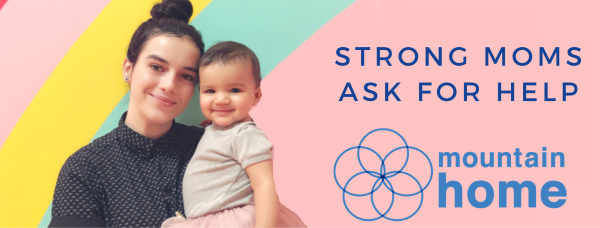The doctor frowns. You’re not sure if he’s judgy or just too-busy. He recommends changing formula. You have questions, but your chapped lips feel glued shut. You bundle your baby into her car seat, rush outside the health clinic, hop onto the bus then off again at the nearest grocery store, and grab a can of the recommended formula. At the checkout counter, your hands go cold when you realize the price. How often will I have to buy this stuff? Your stomach does that thing where it simultaneously becomes as heavy as a bowling ball and as trembley as an aspen leaf.
At home, you microwave a Pop Tart for yourself for dinner, dig through the laundry for your least-dirty black jeans to wear to work, change your baby’s diaper, respond to two of the five texts from your mother. When the babysitter arrives, you promise her you won’t be late tonight even though the restaurant where you work refuses to close if customers choose to linger, so in reality, who knows when you’ll be back?
Your head is throbbing and you toss back two Advil and a glass of water before kissing your daughter goodnight. She smells like the moon and stars. Also, a little bit like cheese.
You serve customers expensive spaghetti and cheap red wine for six hours. Return home. Pay the babysitter roughly half of what you just earned. Collapse into bed.
Tomorrow morning: repeat.
In Burnout: The Secret to Unlocking the Stress Cycle, authors Emily and Amelia Nagoski point out that the human body evolved to experience stress as a cycle with a beginning, middle, and end. But most women–especially moms–get stuck barely halfway through that process before we’re experiencing a whole new set of challenges. The unresolved emotions linger in our bodies, often getting up to no-good.
“We’ve lost count of the number of women who have told us they have been hospitalized or have experienced chronic illness as a result of intense, long-term stress,” the Nagoski sisters told the lifestyle magazine, Goop.
Back when our main threats were physical, say a tiger, our bodies would be flooded with stress hormones that primed our body to physically respond. The first sight of the tiger would signal the beginning of the stress cycle. The next stage of the process would involve something like running from the tiger. The end phase of the cycle happened when we made it all the way to the village, inside our friend’s cozy home, when we would hug the friend, celebrate our safety, then take a nice long nap. A stress cycle would be complete, and we’d awake ready to experience peace and/or whatever threat came next.
In Burnout, the Nagoskis acknowledge that sexism and racism and classism and a whole bunch of other ism’s are causing our very real modern-day stress. But it’s unlikely that we can effectively contribute to change if we’re utterly exhausted from carrying the weight of a million unresolved stress cycles. And because most modern stress doesn’t have an inevitable cycle (we’re rarely getting exercise by running from tigers), we have to consciously start noticing when we’re experiencing stress in our body. We must then take action to close that particular stress cycle. This Brene Brown podcast with the Burnout authors outlined seven efficient methods to try.
1. Physical activity. Any. Movement. Of. Your. Body. The Nagoskis promise that we don’t have to suddenly run the Missoula Marathon. They say that any movement will help, including simply standing up, tensing every single muscle in your body as hard as you can, until you’re shaking with the effort, then collapsing on the floor. (May want to let your office mate know what you’re doing first, though.)
2. Breathing. Take a slow breath in and slow long breath out. Don’t overthink this. Just breathe.
3. Positive social interaction. This can be a phone call with a friend or even just a friendly back-and-forth with a coworker. No matter where you are, an upbeat and/or empathetic conversation tells your body that you are safe, you are home.
4. Laughter. The real deal–like the kind where you almost pee your pants–will take you all the way through the end of the stress cycle. Interestingly, the Nagoskis say that it’s surprisingly effective even to simply tell someone else about that time you laughed so hard you tore your C-section stitches. Our memories have power!
5. Affection. Specifically, try a twenty-second hug. The trick is to lean into it while maintaining your own center of gravity. (And isn’t that the trick to pretty much everything?) If you don’t have an adult in your life that you trust to do this activity with, and your kids are too squirmy, pets can do the trick! So can prayer or loving-kindness meditations that create a sense of spiritual connection.
6. Crying. Tears may not solve the problem itself, but allowing the emotion to be fully expressed can help complete the stress cycle.
7. Creative expression. Paint. Dance. Bead. Sing. Write. Whatever works for taking what is inside of you and getting it outside of you.
Fair warning, Strong Mom: none of these strategies can immediately solve the pain or exhaustion from a lifetime of incomplete stress cycles. And they certainly won’t prevent new cycles from starting. (The causes of the stress are often outside of our control.) But they will help incrementally move us closer to peace and well-being.
While there’s not a way to avoid the thousand different tunnels of stress, we can get better at finding our way out.
Every day. Together.
And don’t forget that you can reach out to Mountain Home’s Community Center at (406) 360-3929 for all kinds of stress-cycle breaking support.
You’ve got this Strong Mom!

